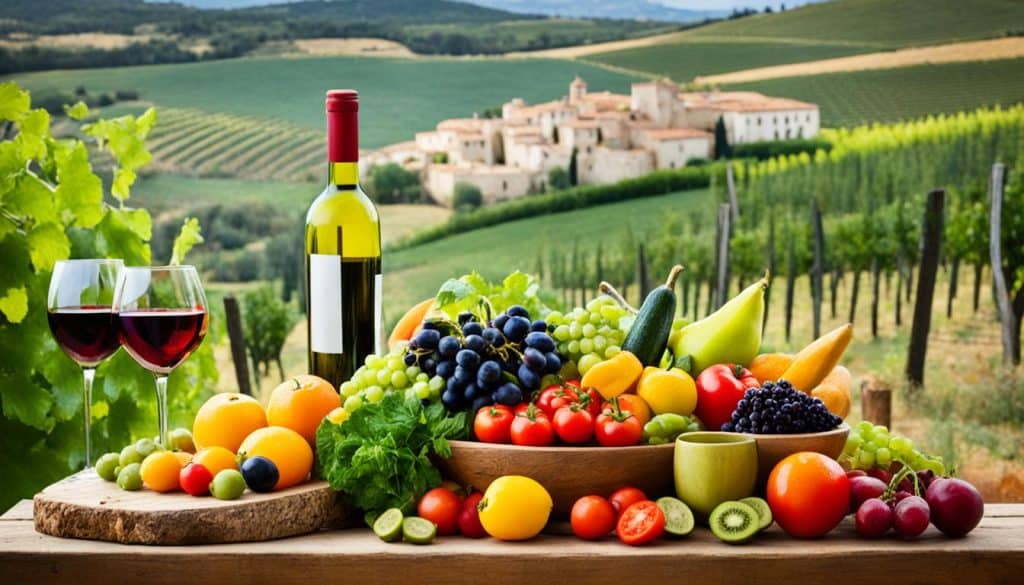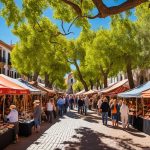Spain’s food and beverage industry is a key player in its economy. It brings together rich culinary traditions and cutting-edge foodtech. This powerful combo places Spain among the top food capitals worldwide. The sector contributes 10% to Spain’s GDP and supports over 2.8 million jobs. Not to mention, it draws in tourists from around the globe. They come to savor Spain’s amazing food and drinks.
Key Takeaways:
- The food and beverage industry in Spain is a vital part of the country’s economy.
- Spain is renowned for its culinary traditions and diverse regional cuisines.
- The industry contributes significantly to tourism in Spain.
- The industry’s innovations in foodtech have helped it become a global gastronomic capital.
- Spain’s food and beverage industry creates millions of jobs and contributes 10% of the national GDP.
An Overview of Spain’s Restaurants, Cafés, and Bakeries
Spain’s food world is exciting and varies a lot. It has all sorts of places to eat or drink, like restaurants, cafés, and bakeries. In both busy cities and lovely small towns, there’s something for everyone.
The Restaurant Scene in Spain
In Spain, restaurants show how great the country’s food really is. You’ll find traditional tapas bars and famous restaurants in big cities. Places like Madrid and Barcelona have top spots that mix new ideas with cooking skills for great meals.
Regional Restaurants with Local Flavors
Spain’s regional restaurants celebrate its varied food traditions. You can taste Catalonia’s innovative dishes or Andalusia’s hearty meals. Enjoying paella in Valencia or trying pintxos in the Basque Country lets you taste real Spanish flavors.
Café Culture and Inviting Spaces
Café life is important in Spain. Cafés are everywhere, from busy squares to quiet spots. They’re perfect for taking a break and trying some snacks or light meals. You can enjoy a cortado or a churro with hot chocolate and experience Spanish welcoming vibes.
Diverse Bakeries for Every Palate
Spain loves its bakeries and the variety shows it. The streets have traditional bakeries with the smell of fresh bread and sweets. There are also modern ones with special options like gluten-free or organic. Spain’s bakeries offer something delicious for everyone, from baguettes to pastries.
| Establishment | Description |
|---|---|
| Restaurants | Spain’s restaurants range from tapas bars to fancy dining, all showcasing delicious Spanish food. |
| Cafés | Cafés are a big part of life in Spain, offering places for friends to meet over coffee and snacks. |
| Bakeries | Spain’s bakeries, both traditional and modern, bake fresh bread and sweets for everyone to enjoy, catering to various tastes and needs. |
Exploring Restaurants in Spain’s Provinces
Spain’s provinces boast a rich variety of restaurants. Each region offers food that reflects local tastes and customs. From lively coastal spots to busy urban areas, Spain’s dining scene is as diverse as its landscapes.
Catalonia
Catalonia, especially Barcelona, is famous for its food innovation and emphasis on local produce. Its restaurants blend tradition with progressive ideas to craft delicious meals. Patrons can enjoy everything from Catalan classics to cutting-edge dishes.
Andalusia
Andalusia’s cuisine combines Arab and Mediterranean elements. Highlights include olive oil and sherry wine, which enhance the flavor of its dishes. This region’s dining options range from tapas bars to sophisticated eateries.
Madrid
Madrid, the Spanish capital, welcomes a variety of culinary styles. Its restaurants serve both timeless Spanish dishes and modern, global cuisine. The city’s food landscape caters to its diverse population and visitors alike.
Basque Country
The Basque Country is a food enthusiast’s dream. It’s home to numerous Michelin-starred restaurants and a strong culinary tradition. Specialties include pintxos and fresh seafood, among others.
Sample Regional Restaurants in Spain’s Provinces
For a taste of Catalonia, try Disfrutar Barcelona. This three-Michelin-starred restaurant is celebrated for its avant-garde cuisine.
In Andalusia, Restaurante Alboronía in Malaga offers modern Andalusian food in a stylish setting.
Madrid’s Goizeko Wellington serves traditional Basque dishes in a welcoming atmosphere.
Experience the Basque Country’s flavours at Arzak in San Sebastian, a top restaurant with three Michelin stars.
| Province | Key Highlights | Notable Restaurants |
|---|---|---|
| Catalonia | Gastronomic creativity, farm-to-table dining concepts | Disfrutar Barcelona |
| Andalusia | Rich traditional flavors, olive oils, and sherry wines | Restaurante Alboronía |
| Madrid | Mix of traditional and modern cuisines | Goizeko Wellington |
| Basque Country | Culinary excellence, Michelin-starred restaurants | Arzak |
Traffic Data and Trends in Restaurants, Cafés, and Bakeries
When planning to grow in Spain’s busy food and drink world, it’s vital to know about traffic trends. Spanish dishes draw many customers, especially during peak hours. Traditional Spanish food spots see about 60% footfall then.
Restaurants get the most visitors, with 55% of people coming in their prime time. Next are cafés at 35%, and bakeries welcome 10%. The busiest times are lunch and dinner, while breakfast sees fewer people. These insights can help in picking the best time and place for a business to thrive.
| Type of Establishment | Traffic Percentage |
|---|---|
| Restaurants | 55% |
| Cafés | 35% |
| Bakeries | 10% |
Understanding local tastes and visitor preferences helps in planning. By using traffic data wisely, Spain’s food and drink spots can offer better experiences. This makes customers happier and more likely to return.
Strategies to Increase Traffic for F&B Establishments in Spain
To boost visits to eateries and bars in Spain, you need a good plan and to really know your audience. With the right tactics, businesses can draw in more people and stand out in a tough market.
Localization: A Key to Success
Localization is vital for attracting local customers and more visits. Adding local dishes to the menu and adapting to what locals like can make a big difference. The decor and atmosphere should mirror local culture, making everyone feel at home.
Innovation: Captivating Customers
Being innovative helps you shine in Spain’s lively food scene. Modern takes on traditional foods and new menu items can grab attention. Using unique ingredients makes dishes special and can attract food lovers.
Social Media: Engaging with the Audience
Social media is a key way to connect with customers. Engaging posts, fun captions, and interactive content can build a strong online image. Posting mouth-watering photos and sneak-peeks into the kitchen can spark interest and bring in new faces.
Promotions and Events: Creating Buzz
Running promotions and events can really boost visits. Special offers and unique deals can appeal to both locals and tourists. Teaming up with influencers and hosting exciting events can get people talking and attract a crowd.
Partnerships: Expanding Reach
Teaming up with influencers and local businesses can help you reach more people. Collaborations with popular online figures can boost your visibility. Working with local hotels or tour groups offers great cross-promotion chances.
By using these strategies and tailoring them for your audience and area, food and drink spots in Spain can see more visitors, attract more customers, and thrive in a competitive market.
Price Range Analysis for Restaurants, Cafés, and Bakeries in Spain
Understanding the price range for food places in Spain is key for growing a business. Prices change due to location, culture, and food traditions. Knowing about the area’s economy is also vital for setting prices. This helps businesses plan their pricing better.
Price Ranges Across Different Types of Food Establishments
| Establishment Type | Price Range |
|---|---|
| Restaurants | ££-£££ |
| Cafés | £-££ |
| Bakeries | £-££ |
Restaurants usually cost more than cafés and bakeries. This depends on the food quality, experience, and service. In Spain, restaurants offer both mid-range and luxury dining.
Cafés and bakeries are more affordable. Cafés serve light meals and drinks. Bakeries have a variety of baked goods at good prices, for everyone.
Where you are in Spain affects prices too. Big cities like Madrid and Barcelona have higher prices. Smaller towns and countryside areas are cheaper. This is because of different living costs and business expenses.
Factors Influencing the Price Range
- Culinary Traditions: Famous food areas with special ingredients might cost more. This is because of the quality and rare food they offer.
- Tourism Influence: Tourist spots tend to be pricier. They aim to please visitors from around the world with good service.
- Competition: More food spots mean different prices. They try to win over customers with varied costs.
- Local Economy: The local money situation affects food prices. Income levels and living costs play a big part in this.
Food businesses must think about these points when picking their prices. Knowing about price differences and local economies helps. This way, they can make money while staying attractive to buyers.
The Influence of Spanish Food and Drink Globally
Spanish food is loved all over the world. It’s known for its bold flavours and traditional dishes. Many people enjoy these vibrant tastes.
Fresh ingredients are a big deal in Spanish cooking. Local olive oil, juicy tomatoes, and lots of seafood make the dishes special. Spices like chorizo and pimentón give them a memorable taste.
Spain is a major supplier of olive oil, fruits, vegetables, and wine. This shows its big role in global food markets. The country is committed to growing food sustainably and keeping its food traditions alive.
Everywhere, you can find tapas bars and Spanish restaurants. This shows how people from different places love Spanish food. It’s known for being tasty and diverse.
Food is also a big reason people visit Spain. Tourists love trying out Spanish food, like paella or Rioja wine. It’s a key part of their travel experience.
Spanish food ranges from casual tapas to fancy Michelin-starred meals. It wins the hearts of people around the globe. Spain wants to keep its food culture strong for the future.
Spain’s Sustainable Approach to Food and Drink Production
Spain is at the forefront of sustainable food and drink production. It focuses on economic, environmental, and social sustainability. The country has over 400 foodtech startups leading in innovation. They work on alternative proteins and advanced technology. This shows Spain’s growing emphasis on sustainability.
In Spain, sustainability goes beyond just ingredients and how things are made. The country works to be sustainable in farming, food safety, and packaging. By adopting a circular economy, it aims to reduce waste and build a more sustainable industry.
Foodtech Innovations
- Alternative proteins: Spain’s foodtech sector is pioneering in plant-based and lab-grown proteins. These are sustainable alternatives to traditional animal products.
- Technology integration: In Spain, foodtech startups use technology like AI and data analysis. This improves food production efficiency and lessens environmental harm.
- Sustainable packaging: Spain is developing eco-friendly and biodegradable packaging. This helps reduce waste and encourages sustainable habits.
Investments in Sustainability
Spain’s increasing investments show its commitment to the environment and society. There is strong collaboration between the government and businesses. Together, they support sustainability in the food and drink sector.
The Circular Economy
The circular economy is key in Spain’s strategy. It aims to reduce waste, use resources efficiently, and support sustainable habits. This approach covers everything from sourcing materials to cutting down food waste.
Environmental Impact
Spain is working to lessen the environmental effects of producing food and drinks. Efforts are being made to cut down carbon emissions, save water, and protect natural diversity.
Social Responsibility
Social responsibility is also a big part of Spain’s strategy. The food and drink industry aims to better social outcomes. This includes fair work conditions, supporting communities, and promoting health.
Spain is setting a standard for the world with its approach to sustainable food and drink production. Through innovation, investment in alternative proteins, and a focus on sustainability, Spain leads the way to a greener future.
Technological Advancements in Spain’s Food and Drink Industry
Spain’s food and drink industry is using new tech to be more efficient and green. It explores many areas like nanotechnology and artificial intelligence. This change is transforming how the sector works.
Nanotechnology for Sustainable Ingredients and Food Safety
Nanotechnology has changed how ingredients are developed, focusing on safety in Spain. It uses tiny materials to make ingredients that are better for the planet. These new ingredients keep food safe for longer, waste less, and are still tasty.
Vertical Farming and Artificial Intelligence in Smart Agriculture
Vertical farming and AI are now key to Spain’s smart farming. This method uses less space and water, which is good for the planet. AI helps monitor farms closely, leading to better crops and fewer pests.
Predictive AI tools let farmers expect how well they will do, helping them use resources wisely.
Enhancing Food Safety and Traceability with Blockchain
Spain’s food sector is safer and more traceable thanks to blockchain. This tech uses a secure system to make sure food stays pure all through its journey. It lets people check where their food comes from. Blockchain also makes buying and selling more secure and fair.
Increased Efficiency and Sustainability
Spain’s food sector is getting better and greener by using these new technologies. They help make the best use of resources and reduce harm to the environment. The quality and safety of food are also getting better. Thanks to these tech advances, Spain is leading the way in making food and drink production better.
| Technological Advancements | Benefits |
|---|---|
| Nanotechnology | – Sustainable ingredient development – Improved food safety – Enhanced nutritional content |
| Vertical Farming and Artificial Intelligence | – Efficient use of space and resources – Optimal crop growth and productivity – Effective pest and disease control |
| Blockchain | – Enhanced food safety and traceability – Transparent and secure supply chain – Efficient transactions and fair trade |
Sustainable Solutions for Food Waste and Packaging
In Spain, they’re tackling food waste and packaging problems with sustainable solutions. They aim for a greener, more sustainable food and drink industry.
Edible Coatings for Extended Shelf Life
In Spain, they’re creating edible coatings for fruits and veggies. Made from natural ingredients, these coatings keep produce fresh longer. They cut down food waste and let folks enjoy fresh food for more days.
Promoting a Circular Economy with By-Products
Spanish start-ups use food manufacturing leftovers to support a circular economy. They turn by-products into valuable resources. For instance, leftover pulp becomes nutritious snacks or natural dyes, and unused grains feed animals or make biofuels. This slashes food waste and uses resources to the fullest.
Digital Platforms for Resource Optimization
Spain is also using digital platforms to cut waste. These platforms help businesses swap by-products and waste. They connect producers, manufacturers, and suppliers. This makes using resources efficient and helps reduce waste.
Spain’s steps towards sustainability are helping fight food waste and make the food industry eco-friendlier. Edible coatings, repurposing by-products, and digital platforms are leading Spain towards a greener future.
Passion and Tradition in Spanish Food and Drink
Spanish cuisine is a lively reflection of the country’s passion and tradition. It has evolved over centuries, mixing various cultures. The result is a culinary experience that values simplicity and respect for ingredients, capturing the heart of Spanish cooking.
In Spain, cooking is all about simplicity and bringing out the best in each ingredient. Staples like olive oil, tomatoes, and seafood blend to create unbeatable flavors. These ingredients are the stars of Spanish dishes, enjoyed both locally and worldwide. Spanish wines, like the famous Rioja, add a perfect touch to these meals.
But Spanish cuisine does more than feed the body. It brings people together, creating a warm, friendly community. Sharing a meal is a chance to bond and celebrate with others. This social aspect of eating is key in Spanish culture, enhancing the dining experience.
The Importance of Culinary Traditions
Spain’s culinary traditions are crucial in keeping its food heritage alive. These traditions range from tapas to regional specialties. Passed down through families, they show the lasting importance of food in Spanish culture.
Traditional recipes and cooking methods are cherished. They make sure old flavors stay present in today’s dishes. Whether it’s paella in Valencia or pintxos in the Basque Country, these meals pay homage to Spain’s culinary history.
A Table of Spanish Delights
| Dish | Description | Region |
|---|---|---|
| Gazpacho | A refreshing cold tomato soup, perfect for hot summer days | Andalusia |
| Jamon Iberico | A prized cured ham, known for its intense flavor and melt-in-your-mouth texture | Various regions |
| Tortilla Española | A classic Spanish omelette made with potatoes and eggs, served as a tapa or a main dish | Various regions |
| Paella | A saffron-infused rice dish with a variety of ingredients such as chicken, rabbit, seafood, and vegetables | Valencia |
| Sangria | A refreshing traditional Spanish drink made with red wine, fruit, and spices | Various regions |
Here are some culinary highlights from Spain’s rich regions. Each dish tells its own story of Spanish culture and tradition.
Spanish cuisine is a feast for the senses, reflecting centuries of history and the country’s culinary passion. Whether in a lively tapas bar, a traditional family meal, or a top-rated restaurant, Spanish food and drink create unforgettable experiences.
ICEX Spain Trade and Investment’s Role in Promoting Spanish Food
ICEX Spain Trade and Investment plays a crucial role globally as the International Partner for the Sustainable Food Forum. It works closely with Spanish producers and exporters. The goal is to introduce new products and help existing ones flourish in new markets.
The forum is a great place to share how Spain focuses on sustainable and innovative food and drink. Industry leaders and experts come together to talk about making food in ways that are good for the planet. This event helps people to network, share knowledge, and find partners for new projects.
ICEX boosts the visibility of Spanish food abroad. By taking part in trade missions and international fairs, it helps Spanish food break into new markets. This strengthens relationships with partners worldwide.
ICEX has a vast network that aids Spanish companies in mastering global trade. It helps with market research and connects companies with potential buyers. This guidance is vital for companies aiming to enter new markets successfully.
ICEX also champions innovation and the digital world in food trading. It encourages the adoption of e-commerce and online marketing. This approach is key for reaching global customers in today’s digital age.
By leading various initiatives, ICEX ensures Spanish food stays relevant in the culinary world. It’s focus on sustainability, market development, and innovation makes Spanish food stand out. This commitment assures that Spanish cuisine is known for its top-notch taste, quality, and authenticity.
Conclusion
Spain’s food and drink sector is lively and mixes old food traditions with new sustainable ideas. It’s known worldwide for its excellent food and care for top-notch ingredients. The push for sustainability and new technologies makes Spain a model for others in the food world.
Companies can find great opportunities in Spain by understanding the market. Spain’s cuisine combines classic tastes with modern cooking, drawing both locals and tourists. It also focuses on keeping its food traditions alive for future generations with its strong commitment to being eco-friendly.
Spain’s food industry values innovation and quality, which promises more growth and achievements. As it changes, Spanish businesses can grow by staying sustainable, using new tech, and meeting changing customer likes and needs.














